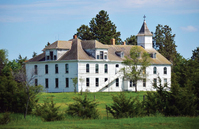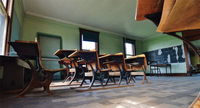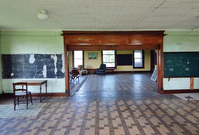In researching for new locations to photograph, Ryan came across information on an old convent school. Now of course I’m picturing old movie scenes of nuns with rulers in hand, children in uniformed clothing sitting up straight in tiny desks lined up in rows, with terrified looks on their faces wondering who would be smacked next with that ruler. So, of course I jump at the thought of photographing a convent!
Ryan mapped out where we were headed and as it was past Aberdeen, South Dakota, we chose an extended weekend during Memorial Day a few years ago to make the trek.
Just west of Aberdeen, sits a tiny little town called Zell. Across the main road from the community stands with authority a three story abandoned Catholic Convent School. Upon approaching the dirt street that leads up to the Convent our mouths had dropped open and we were both speechless. This place of history was absolutely enormous. Right next to the Convent is the cemetery and at the end of the street is the current church. We both grab our gear and damn near leaped out of the truck before it was put in park and shut off! As I stood in long grass up to my knees photographing the outside of the Convent, I’m approached by an older gentleman who had been at the cemetery laying flowers for past relatives. He spotted my camera and asked who I was with, I stated my husband. He laughed, referring to a publication as there had been media outlets in the past that had been there, “oh”, I said, and explained that we just do this for a hobby of documenting with our cameras unique and abandoned locations before they are gone. I asked him if it was open to go inside, he stated, his cousin owned the property and his home was just across the street, he was going to go check with him. I quickly find Ryan who is at the backside of the Convent photographing a crazy looking contraption that was attached at the second or third floor and coming down to the ground. I ask, “What on earth is that?” Ryan tells me it is a fire shoot; in case of a fire this would’ve allowed the children and nuns to escape. I proceed to tell him about the older gentleman I just met.
Now every once in a while you get the opportunity of a lifetime and this was ours. The older gentleman came back with his sister and we followed him in. Our now tour guide began sharing the history, his ancestors, Austrian immigrants had settled near Redfield, South Dakota, and they named their settlement Maria-Zell. The letters, M and Z are carved as part of the design above the windows on the upper floors on the outside to represent Maria-Zell. The Convent School was built in 1883 before South Dakota became a state. The Convent was established by Bishop Martin Marty who wanted a place to train teachers for the Catholic missions to tribal reservations. The Sisters who lived there as teachers, managed a farm from 1915 to support the school. The Sisters owned the land and raised their own meat, gardened and milked up to thirty cows. Most of the children grades one to eight spoke German and were taught English. Many children farther away came by bus and boarded there.
Once we entered the large classrooms the existing chalkboards are filled with the history and all written in cursive hand writing. The original cast iron desks are present along with older pieces of furniture in not so great conditions. Ryan and I split up, I with the older gentleman and Ryan with his sister. I follow him out of the two very large classrooms and across the hallway to the chapel. He tells me that when he went to school here that he remembers helping with mass in the chapel. The wooden pews are present and the wooden kneelers had no padding. He tells me, “Boy those were uncomfortable to kneel on and there was no sitting instead of kneeling!” We continue down a long hallway to several other rooms on the main floor. There was a large kitchen at the end that still held an old refrigerator and ice box. A smaller room across the hallway still holds a piano and next to it was an eight track player. He tells me that this was the music room where the Sister’s taught music lessons. There is a back staircase that has an interesting cut out design in the wooden banister that leads up to the second floor, we choose to head down the back stairs to the basement instead. He tells me that lunch was served in the basement and at a time there were one hundred students to be fed. The basement held the boarder’s dining room, the day student’s dining room, the priest’s dining room; the kitchen with a cellar like storeroom is off to the side.
Now to say dining room for the student’s is a bit of a stretch as he shows me where they would’ve eaten. Down a long cement walk, which appears to be a hallway, he said would’ve been a long wooden table and benches. “This is where we ate lunch every day.” My tour guide got a bit nervous in the basement as it was pitch black and asked me if I saw any ghosts. He did not want to stay very long down there even when I had reassured him with my flashlight. He tells me that even when he was a kid he never liked coming down here, he always felt as if he was being watched. I shot almost two hundred photos while we were there and did not find a ghost present in a single one!
We make our way up the stairwell to the main floor, now back at the front of the school and continue up the main stairwell to the second floor. There were three dorm rooms on the second floor and two bathrooms. Now at the time when he went to school there, there was no running water and no indoor bathrooms. The outhouses, which are still standing are on the south side of the Convent
School. The boy’s outhouse has four doors and the girl’s outhouse has three doors. I asked him why the different number of doors between the boys and girls, and he proceeds to say, “You know, I never questioned it, I have no idea!” Later an addition was added giving the Sister’s a bathroom to share, this was sometime between 1911 and 1912. In one of the far rooms stood a wooden type of rack that had tiny metal hooks on the top and several small metal trays. He tells me that the children who boarded here would have used this to wash up with. It would’ve held basins of water, and their soap sat on the trays and on top where the small hooks were, is where they would’ve hung their wash clothes. In the next room over the only items present are two very small metal beds with springs. Ryan would comment on these on our drive home as we shared back and forth all we saw and had learned from our tour guides. “Did you see those two small beds on the second floor, he asked me.” I have never seen a bed so small in my life” he continues with excitement.
My tour guide and I continue up the stairs to the third floor which is in rough shape. There is water damage on the ceilings due to the aging roof and plaster falling off the walls in many spots. My tour guide states that it has been very costly to try and make repairs to keep the Convent School from falling apart any more that it has already. Down the back staircase he leads me, and back to the main floor and entry way where we meet up with his sister and Ryan. The Convent School was closed in 1963 due to hard times and it couldn’t meet the fire safety codes. The St. Mary’s Convent School is listed on the National Register of Historic Places and is privately owned. I never got the name of this gentleman, but we thanked him and his sister for humoring us with their stories and sharing the history with us.
The next time you take a trip and are headed to Aberdeen, get out a map and locate the directions to Zell, just to see the historical place even if it’s just from the outside is worth the trip!!





